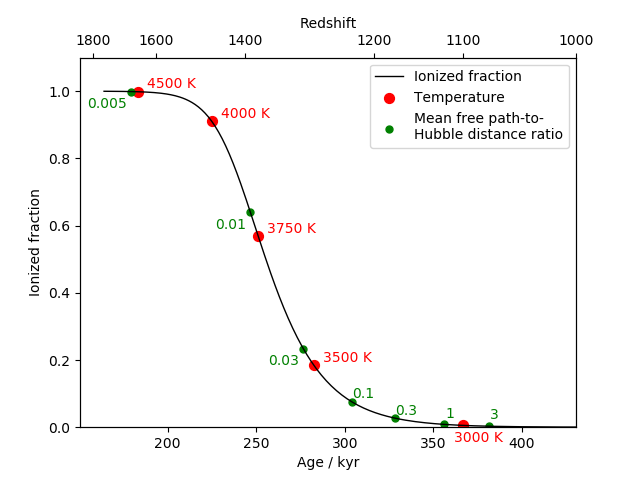I think this is at best a weird typo, but more likely a confusion by the authors (who are not cosmologists or astronomers, but a biologist and a geologist).
The book is 10 years old, but our view of the timeline of the evolution of the Universe was pretty much the same then. Note that the calculation of the size of the Universe as a function of time is a bit more complicated than you assert, because it expands while photons are traveling.
The three number that the authors give — $200\,000\,\mathrm{yr}$, $2\,700\,^\circ\mathrm{C}$, and 100 million lightyears (Mlyr) — do not correspond to the same epochs, as I will discuss here:
Recombination began at t ~ 200,000 yr
The process the authors discuss is known as the recombination of hydrogen, followed by the decoupling of light from the gas. At an age of $200\,000\,\mathrm{yr}$, the Universe had cooled to $4\,500\,\mathrm{K}$, and atoms began to recombine. At this point, the region that is the observable Universe today had a radius of almost 30 Mlyr, i.e. a volume of some $10^5\,\mathrm{Mlyr}^3$. However, the observable Universe at that time was much smaller, because light hadn't traveled so far — the radius was less than half a Mlyr.
Photons decoupled at T ~ 2,700 ºC
The photons didn't decouple yet, though. Exactly when this happened is a somewhat extended period of time, but can be taken to be the time when the mean free path of a photon is of the order of the size of the observable Universe. This happened around when the Universe was $380\,000\,\mathrm{yr}$, at which time it had cooled to $3000\,\mathrm{K}$, or $2\,700\,^\circ\mathrm{C}$. At this time the radius of today's observable Universe was still only around 40 Mlyr, while the observable Universe at that time was still less than 1 Mlyr.
The diameter of the Universe reached 100 Myr much later
When the Universe was roughly half a million years old, the radius of today's observable Universe had expanded to 50 Mlyr, so its diameter was 100 Mlyr. But firstly, this was quite a lot later than the recombination/decoupling, and secondly it doesn't make much sense to refer to the size of today's observable Universe, since that had no physical significance at that time. The radius of the then's observable Universe didn't reach 100 Mlyr until the Universe was almost 20 million years old
Summary in a figure
The figure below shows how the progression of recombination, from ~100% ionized gas when the Universe was around $200\,000\,\mathrm{yr}$, to ~100% neutral gas when it was $\sim 400\,000\,\mathrm{yr}$. I calculated this by solving the Saha equation assuming a pure hydrogen gas, i.e. neglecting helium, but this is a minor contribution so I think it should be okay.
Along the line you see corresponding temperatures in red, and ratios between the photon mean free path and Hubble distance (~size of the Universe) in green. When this ratio is of order unity, photons decouple. The secondary $x$ axis show the corresponding redshift.

